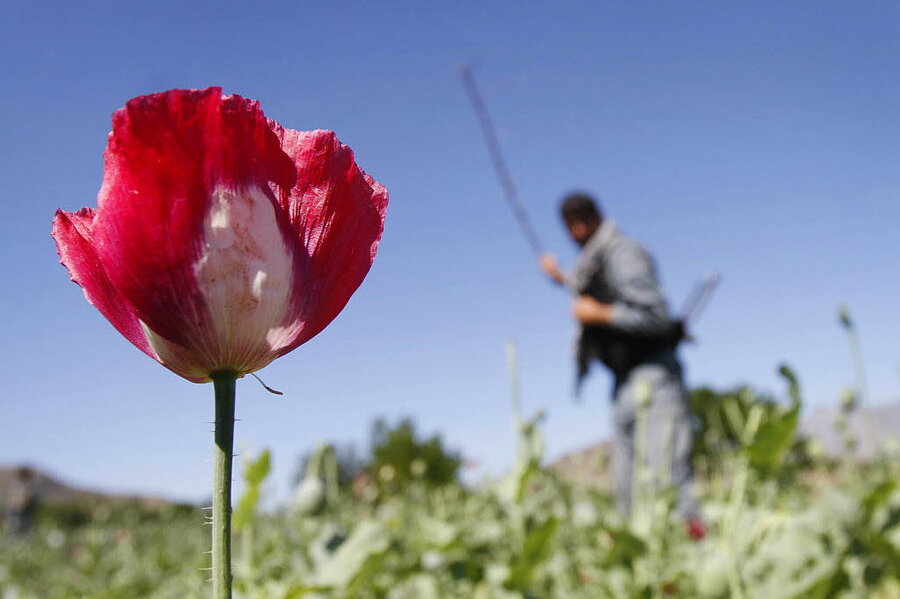Resurgent Afghanistan drug trade threatening US goals, Pentagon warns
Loading...
| Washington
The drug problem in Afghanistan is growing, and it threatens to undermine the US war effort of building a stable country there, top Pentagon officials say in some of the sharpest warnings they have ever issued on the topic.
The lucrative opium trade has been surging in recent years, even as less of the crop is being seized, officials and recent reports say, and with the US military presence in the country winding down, prospects for keeping the illicit business in check are dwindling.
Just how to take on Afghanistan’s opium poppy trade, however, has long been a tricky proposition for the US military.
Destroy the crops – a sizable source of income for poor farmers in a desperately poor country – and risk the ire of Afghan locals, who may turn to violence to protect their livelihood.
But the poppy trade, which supplies the world’s heroin dealers, is also an important source of income for the Taliban – an estimated one quarter of their $400 million annual budget comes from the crops, according to the Department of Defense.
The drug also contributes to corruption within the Afghan government, which in turns alienates the population, making them more open to ideas of alternate sources of government like the Taliban is offering.
So, what is the status of the opium trade in Afghanistan today? It turns out that last year it reached record levels, with production up 36 percent over 2012, in the latest studies made public in a little-noticed hearing last week of the Senate Caucus on International Narcotics Control.
While the Pentagon has invested $2 billion in counternarcotics training and programs, “We do not believe that $2 billion has been well spent,” said Eric Logan, principal director of the Office of the Deputy Assistant Secretary of Defense for Counternarcotics and Global Threats.
Today Canada, for example, estimates that 90 percent of the heroin on its streets comes from Afghanistan.
The governor of the state of Vermont recently gave a speech “focused entirely on Vermont’s exploding heroin problem,” Mr. Logan reminded lawmakers.
These trends point to problems on the ground in Afghanistan. “As we look at the future of Afghanistan, it is impossible to envision success without sustaining an Afghan capability to fight the violence and corruption created by the drug trade,” Logan said.
They are thoughts echoed by the Special Inspector General for Afghanistan Reconstruction (SIGAR), who also spoke at the hearing.
Despite US intervention efforts, overall insurgent funding from narcotics trafficking remains largely unchanged, and the Taliban now shows “greater propensity to protect the poppy harvest and regulate narcotics trafficking and production,” said John Sopko, the SIGAR.
What’s more, because of violence on the ground, law enforcement officers no longer have the same freedom of movement as in previous years, Mr. Sopko added.
Overall, the Pentagon has acknowledged that “drug nexus targets have a lower priority than traditional military targets and that, with their ability to quickly adapt to new tactics, narcotics networks are likely to continue to function,” Sopko told the lawmakers.
Even as drug production has increased, the ability of law enforcement figures to interdict the drugs has diminished.
Indeed, the amount of illicit narcotics seized in Afghanistan has dropped by more than half in the last three years, going from 98 metric tons of opium seized in 2011 to 41 metric tons in 2013.
Perhaps most troubling, Sopko added, is that with the end of the US military’s combat operations, by December, 2014, the Pentagon “will not have the resources and capacity to support law enforcement counterdrug missions at current levels.”
Sopko then issued one of his strongest warnings during his tenure as SIGAR to lawmakers.
“The Afghan drug problem is growing and threatens to undermine the overall US mission to build a stable Afghanistan,” he told them. “Absent effective counternarcotics programs,” he added, “everything we have invested – in both lives and treasure – will be at risk.”







